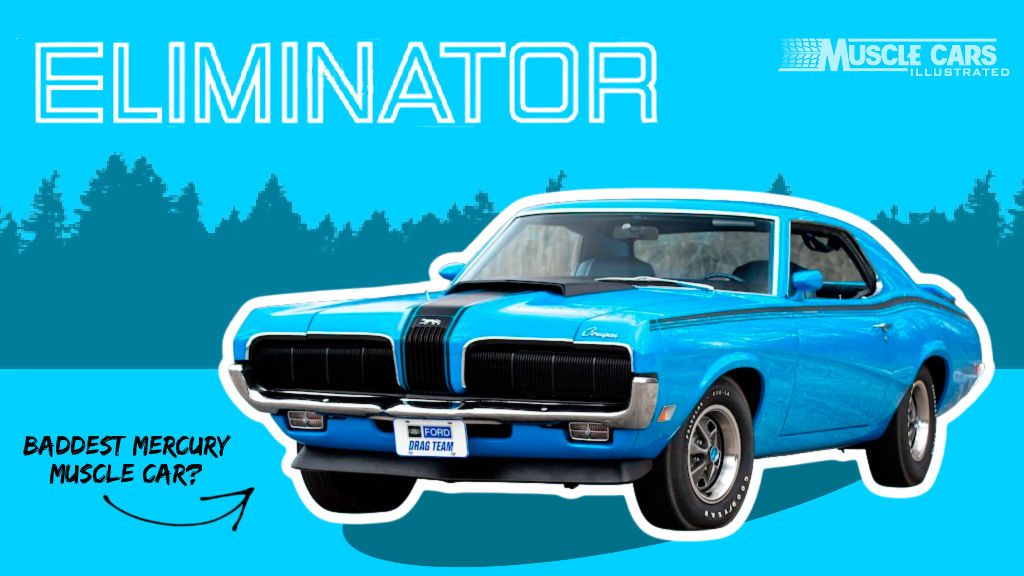
The Mercury Cougar Eliminator has been widely regarded as the ultimate street light predator produced by Mercury.
Its reputation as a true muscle car is backed up by a 1970 advertisement that boldly stated: “New Cougar Eliminator. Password for action. Spoilers hold it down. Nothing holds it back.”
And that was no exaggeration.
The Eliminator’s powerful engine options, performance-tuned suspension, and front and rear spoilers made it a force to be reckoned with on the streets.
Its menacing appearance and unmistakable badging only added to the intimidation factor.
The Cougar Eliminator lived up to its name as it eliminated the competition, leaving many in the dust.
Table of Contents
Mercury Cougar Eliminator Highlights
| Aspect | Description |
|---|---|
| Eliminator Package | The Cougar Eliminator was a high-performance model of the Cougar, produced between 1969 and 1970, which showcased the perfect blend of luxury and performance in a muscle car. |
| Bold Exterior Colors | The Cougar Eliminator was available in various vibrant exterior colors, including Competition Orange, Bright Blue Metallic, and Yellow, making it stand out on the streets and adding to its unique personality. |
| Powerful Engine Options | This muscle car came with several engine options, including the 351 Windsor, 390 FE, and the highly coveted 428 Cobra Jet, offering buyers a choice of power and performance to suit their preferences. |
| Performance Features | The Eliminator package featured numerous performance enhancements, such as a performance-tuned suspension, front and rear spoilers, a hood scoop, and optional Ram Air induction, which improved handling and aerodynamics. |
| Luxurious Interior | The Cougar Eliminator boasts a well-appointed interior featuring bucket seats, a center console, and optional leather upholstery, providing a comfortable and luxurious driving experience. |
| Limited Production | With only 2,250 units produced in 1969 and 2,268 in 1970, the Eliminator is a rare and valuable collector’s item, appreciated by muscle car aficionados for its unique blend of style and performance. |
| Distinctive Badging | The Eliminator model stood out with its distinctive badging and graphics, including the bold “ELIMINATOR” decals on the rear fenders and the Cougar emblem on the grille, emphasizing its high-performance nature. |
| Enduring Appeal | Though the production of the Eliminator was short-lived, it remains a cherished classic among muscle car enthusiasts, celebrated for its marriage of performance, luxury, and eye-catching design. |
What is a Cougar Eliminator?
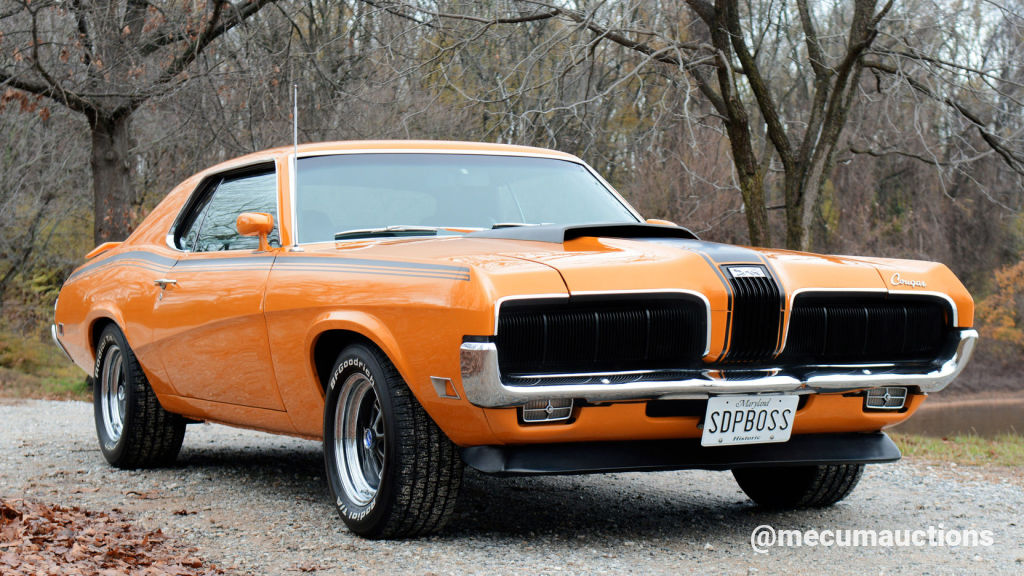
The Eliminator was a two-year-only appearance package built on the Mercury Cougar platform.
From 1969 to 1970, the Mercury Cougar Eliminator had all the right stuff to be one of the greatest American Muscle Cars during the Muscle Car Era, including vibrant paint colors, striping, a hood scoop, spoilers, and many high-horsepower engine options.
In many respects, it was Mercury’s answer to the Pontiac GTO Judge, Oldsmobile 4-4-2 W30, and the Buick GSX.
With vibrant paint colors, striping, hood scoop, spoilers, and high horsepower engine options, it couldn’t help but turn heads and burn tires between stop lights.
First, Mercury took the Eliminator name straight off the race track famous for two-vehicle, tournament-style drag race eliminations.
Second, Larry Shinoda designed the 1969 Boss 302 Mustang and crafted the 1969 Mercury Eliminator’s intimidating appearance package.
Third, you could choose from four performance engine options, including a 351cid Windsor, Boss 302, 390cid, and 428 Cobra Jet.
And it didn’t stop there.
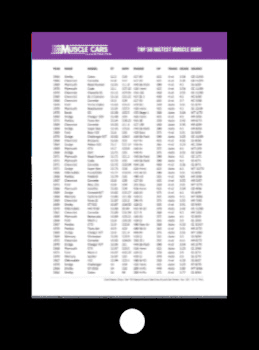
Get The Top 50 Fastest Muscle Cars chart. Includes year, model, engine, 1/4 mile times, and more—absolutely free!
Quick Comparison
| Specification | 1969 Mercury Cougar Eliminator | 1970 Mercury Cougar Eliminator |
|---|---|---|
| Engine Options | 5 | 3 |
| Paint Color Options | 4 | 10 |
| Cost of Eliminator Package | $199.50 | $357.60 |
| Base Price | $3,294 | $3,783 |
| Production Numbers | 2,250 | 2,268 |
Let’s look at all the details surrounding the 1969 and 1970 models, shall we?
1969 Mercury Cougar Eliminator
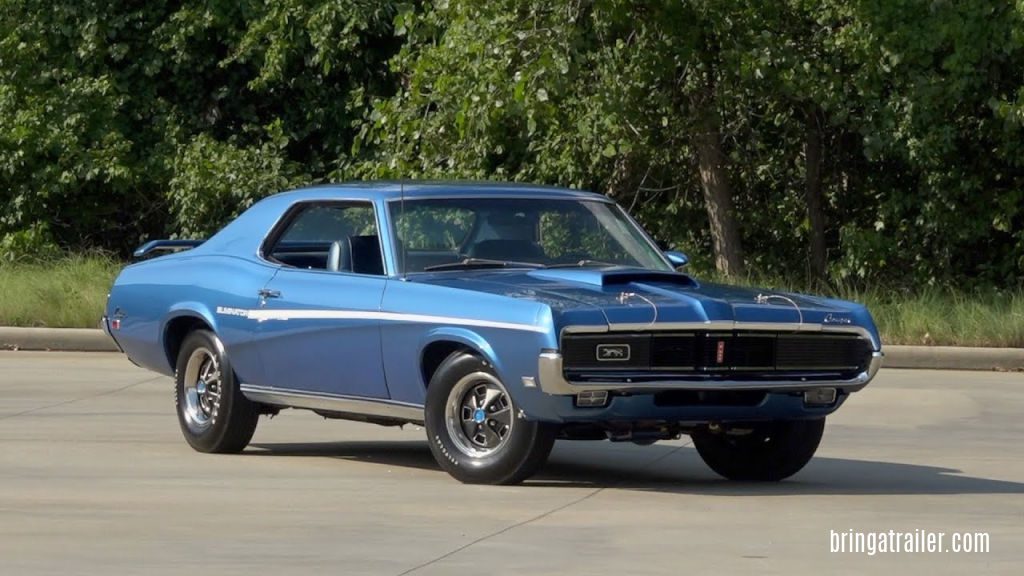
The Cougar Eliminator debuted as a prototype at the prestigious Los Angeles Auto Show in October 1968. Its sleek design, aggressive styling, and powerful engine options garnered an immediate positive reaction from critics and car enthusiasts alike.
In response to this overwhelming response, Lincoln-Mercury executives fast-tracked the release of the Boss 302 version of the Cougar Eliminator for a mid-year release.In contrast, the remaining three engine options were released in the early Spring of 1969.
Once the Cougar Eliminator was officially released, Mercury wasted no time in meeting the demand for this impressive muscle car. In 1969, they built 2,250 Cougar Eliminators.
The Cougar Eliminator option combined three options: the Eliminator Package ($129.60), the Eliminator Decor Group ($69.90), and the Performance Tire/Handling Group.
This combination of options ensured that the Cougar Eliminator was powerful and fast and looked the part with its distinctive badging and styling cues.
Appearance
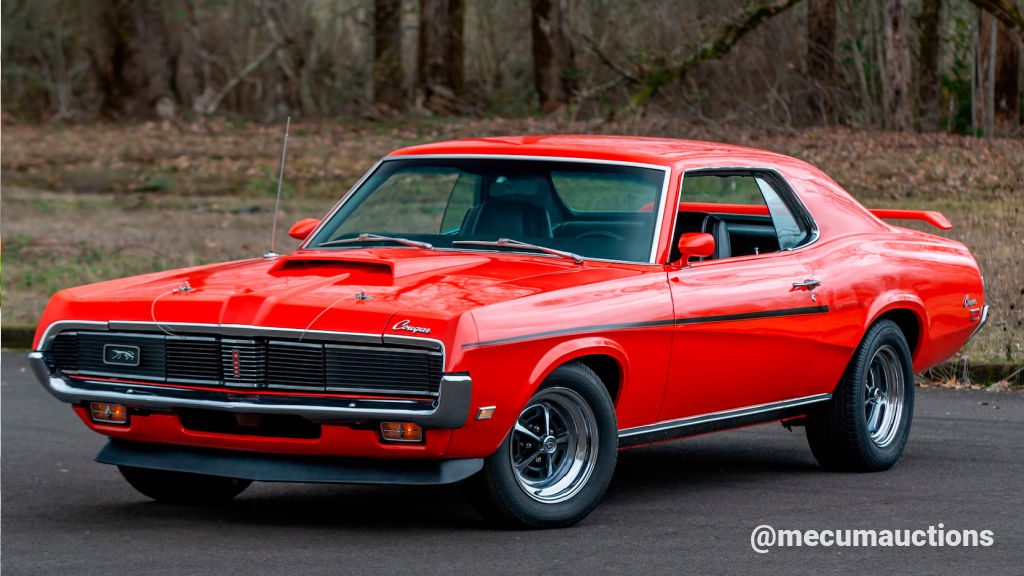
Distinguishing a standard Cougar, XR7, or GT from a Cougar Eliminator was easy to do thanks to the Eliminator appearance add-ons and unique paint colors.
Appearance Package
The 1969 Mercury Cougar Eliminator was a high-performance pony car designed to compete with other pony cars of the era, such as the Pontiac Firebird Trans Am and Chevrolet Camaro.
One of the standout features of the Eliminator was its unique appearance package, which included a range of options and upgrades that set it apart from the standard Cougar.
The package included distinctive styling elements such as racing stripes, front and rear spoilers, a hood scoop, and vibrant paint colors.
Visual Elements
- Front air dam
- Body-colored rear spoiler
- Styled steel wheels
- Black-out front grille
- Body-colored hood scoop
- Eliminator body side stripes (white or black)
- Driver’s side remote racing style mirror
- 12-slot styled steel wheel
Paint Colors
In its debut year, the Eliminator was only available in four eye-catching colors, including white, blue, orange, and yellow.
- Wimbledon White
- Bright Blue Metallic
- Competition Orange
- Bright Yellow
Interior
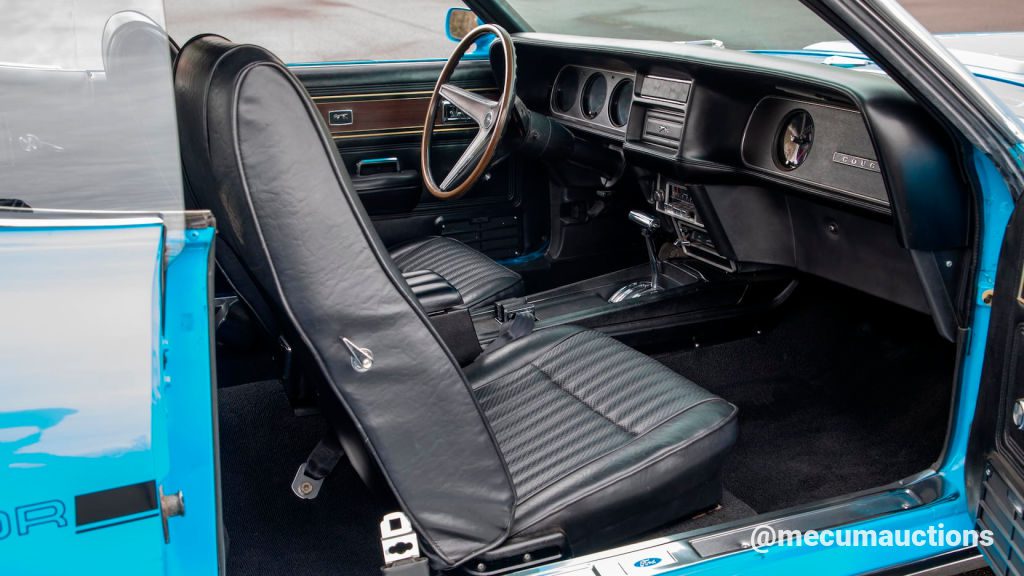
The interior of the 1969 Mercury Cougar Eliminator was just as impressive as its exterior, with a range of features that made it a comfortable and stylish driving experience.
The hi-back black bucket seats were a hallmark of the Eliminator’s sporty design, providing both support and comfort for the driver and passenger.
The center console featured a storage compartment, a clock, and a tachometer, essential for monitoring the engine’s RPMs.
The Eliminator also included a woodgrain steering wheel and simulated woodgrain on the dash and door panels, adding a touch of elegance to the car’s overall design.
With its combination of style and comfort, the interior of the 1969 Mercury Cougar Eliminator perfectly complemented its high-performance engine and distinctive appearance package.
Three interior color choices were available, including black, white, and blue.
Interior Highlights
- Hi-Back bucket seats in Comfort Weave
- Black Dashboard
- Black “camera case” instrument panel with 6,000 RPM tachometer (8,000 RPM with Boss 302)
- Full instrumentation (Tachometer, Rallye Clock, Warning Lights, Trip Odometers, etc.)
- Custom door trim
- Rim-blow steering wheel
- Rear seat armrests
- Door courtesy lights
Engine Options
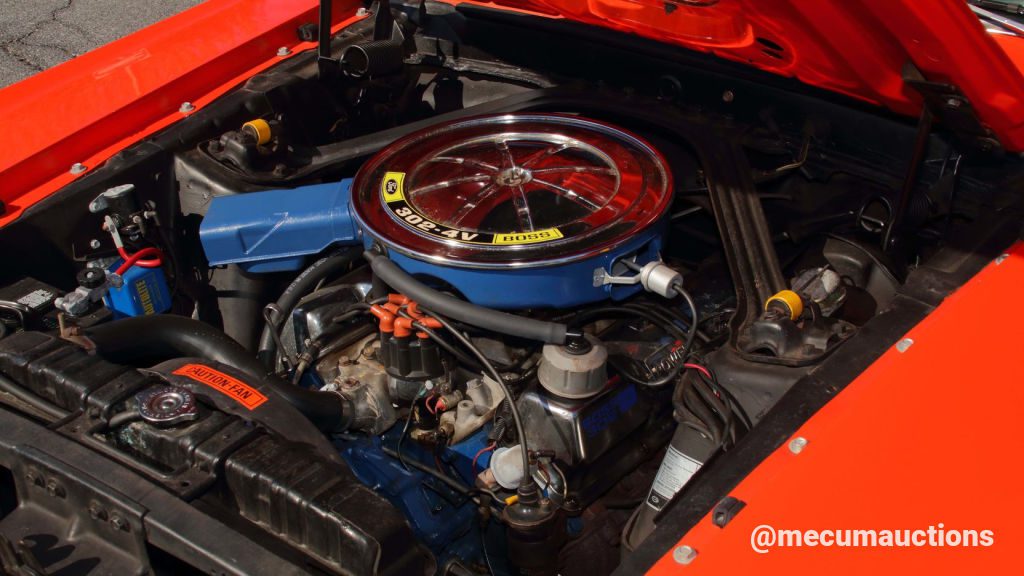
To avoid any false starts regarding engine options on the 1969 Cougar Eliminator, Mercury offered five performance V8 engine choices.
These options included the G, M, Q, R, and S codes, ensuring buyers could choose an engine matching their performance preferences.
In addition to these five engine options, the 1969 Mercury Cougar Eliminator also featured the 351 Windsor and 390 engines, exclusive to that model year.
The 351 Windsor was later replaced by the 351 Cleveland, a popular engine choice in later model years. Meanwhile, the 390 engine was discontinued after 1969.
The engine options for the Mercury Cougar Eliminator ranged in price from $199 (for the 351 Windsor engine) to $603 (for the 428 Cobra Jet engine). The Boss 302 engine cost an additional $394.
Engine Specs
G Code Boss 302
| Type | 8-cylinder |
| Displacement | 302cid |
| Bore & Stroke | 4.00 x 3.00 in |
| Horsepower | 290 |
| Torque | 290 lb-ft |
M Code 351 Windsor
| Type | 8-cylinder |
| Displacement | 351 Windsor |
| Bore & Stroke | 4.00 x 3.50 in |
| Horsepower | 290 |
| Torque | 385 lb-ft |
Q Code / R Code 428 CJ
| Type | 8-cylinder |
| Displacement | 428cid |
| Bore & Stroke | 4.13 x 3.98 in |
| Horsepower | 335 |
| Torque | 440 lb-ft |
S Code 390
| Type | 8-cylinder |
| Displacement | 390cid |
| Bore & Stroke | 4.05 x 3.78 in |
| Horsepower | 320 |
| Torque | 427 lb-ft |
Performance & Handling
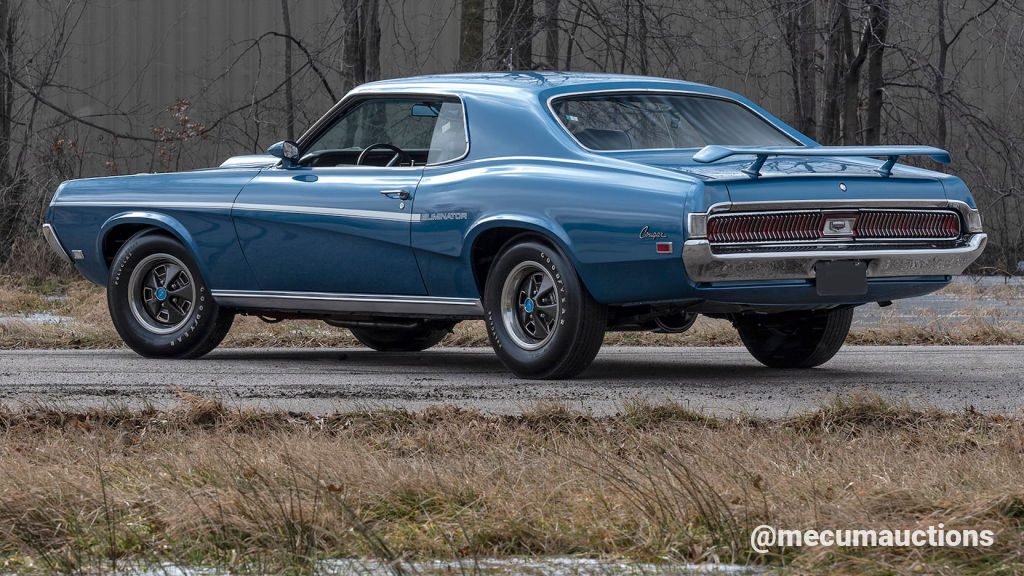
Quarter Mile Performance
The 1969 Mercury Cougar Eliminator was a natural-born predator on the track. When equipped with a 428 Cobra Jet, it was as fast as its Ford cousin—the 1969 Ford Mustang Mach 1.
In the 1969 Supercar Annual magazine, a Mercury Cougar powered by a 428 SCJ, C6 SelectShift automatic, and a 4.31 rear gear ran a 13.90-second quarter-mile, traveling 101.2 mph.
While not outfitted in Eliminator attire, this Cougar utilized the same 428 CJ powerplant, so it’s as close as we’ll get to a published recorded elapsed time.
Handling
The Eliminator was equipped with a Performance Handling Package, which included a larger sway bar, tubular shocks, heavy-duty coil springs, and semi-elliptic leaf springs in the rear.
This package was mandatory for all Eliminators, and it helped to enhance the car’s handling and performance on the road.
Another standard feature on all Eliminators was the F70 Goodyear Polyglas tires, which provided excellent traction and stability.
Combining these tires with the Performance Handling Package allowed a smooth, controlled driving experience.
For the four-speed Boss 302 and 428 CJ Eliminators, staggered rear shocks were triggered to help suppress wheel hop during extreme acceleration.
This feature helped to prevent the wheels from hopping or bouncing off the road, which could cause the car to lose control.
Overall, these features helped to make the 1969 Mercury Cougar Eliminator a true powerhouse on the road.
1970 Mercury Cougar Eliminator
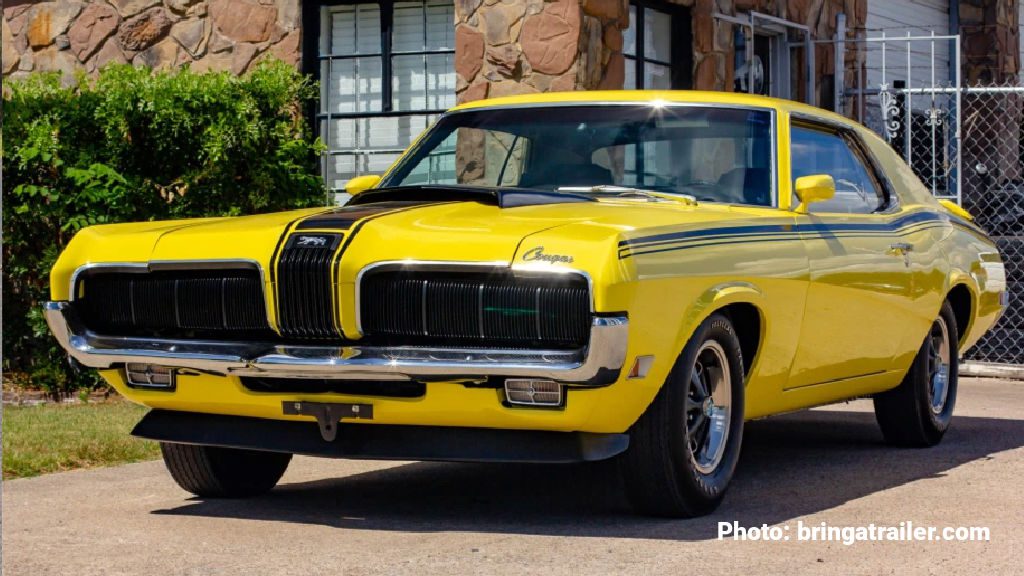
The Cougar Eliminator in 1970, now in its second year of production, received several updates to build upon its early success.
In addition to a wider selection of paint colors, the available power plants were also revamped, ensuring buyers could find the perfect combination of power and performance to suit their needs.
Despite its immediate success the previous year, the 1970 Cougar Eliminator failed to generate higher production numbers, even with the $3,395 bae price.
Mercury only produced 2,268 Cougar Eliminators in 1970, only 18 units more than the previous year.
This limited production makes the 1970 Mercury Cougar Eliminator a rare and valuable collector’s item, appreciated by muscle car enthusiasts for its unique blend of style and performance.
Even with its relatively low production numbers, the Mercury Cougar Eliminator has remained a cherished classic, celebrated for its marriage of luxury and power, making it a true gem in the world of classic cars.
Appearance
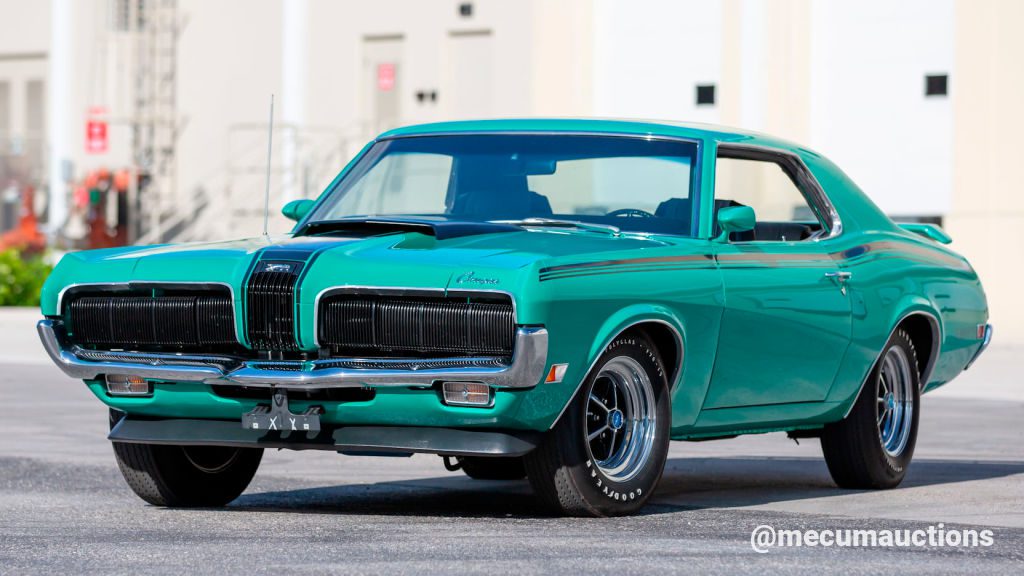
The Eliminator package for the 1970 Mercury Cougar cost $357.60, which included the Eliminator Package, Eliminator Decor Group, and Performance Tire/Handling Group.
One of the key features that set it apart from other cars in its class was its appearance package, which was designed to enhance the car’s already striking design.
The 1970 Eliminator appearance package included a range of options and upgrades that helped to make it one of the most distinctive muscle cars of its time.
- Front air dam
- Black-out front grille
- Black-out hood scoop
- Black-out rear tail light bezels
- Black hood stripe
- Driver side remote racing style mirror
- Passenger side racing style mirror
- Body side stripes (black only)
- Body-colored rear spoiler
- Black rear spoiler stripe with Eliminator callout
- Eliminator callouts on rear quarters
Paint Colors
One of the standout features of the 1970 Mercury Cougar Eliminator was its range of vibrant and eye-catching paint color options that allowed buyers to customize their cars to their personal tastes.
Six standard color options were available on the 70 Eliminator, with additional custom paint color options available.
- Competition Orange
- Competition Yellow
- Competition Blue
- Competition Gold
- Competition Green
- Pastel Blue
- Black (Optional)
- Light Gray Metallic (Optional)
- White (Optional)
- Red( Optional)
1970 Interior
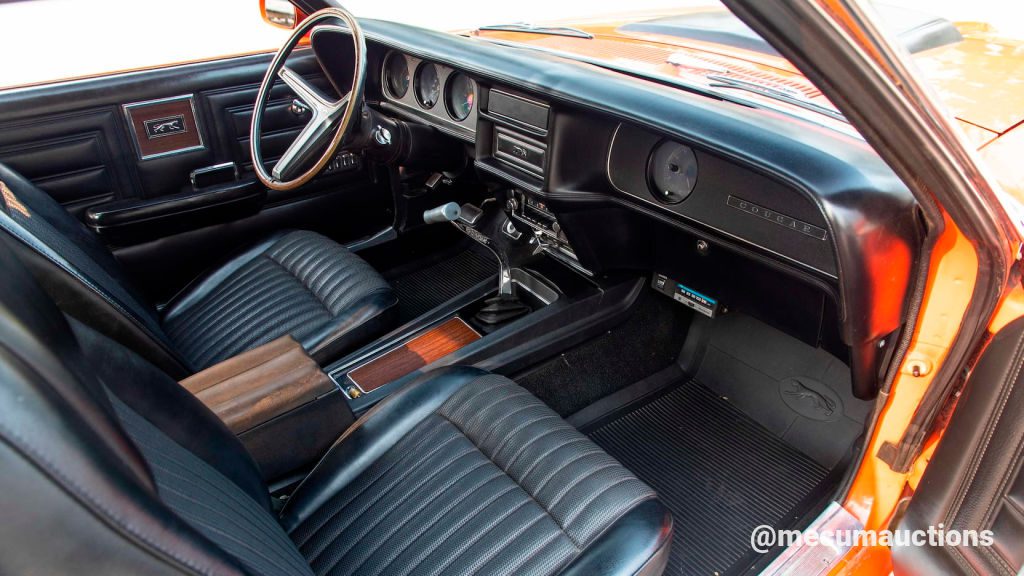
The 1970 Mercury Cougar Eliminator was known for its powerful engine and distinctive appearance and its comfortable and stylish interior.
The Eliminator’s interior was designed to provide a luxurious driving experience while maintaining its sporty and performance-oriented feel.
The interior featured hi-back bucket seats with optional leather or vinyl upholstery and a range of standard features like a wood-grain instrument panel, a floor console with a clock and tachometer, and a deluxe steering wheel.
There were two trim levels (Standard and Decor) and eight different trim colors available, including:
- Black Vinyl
- Medium Blue Vinyl
- Black Vinyl with Houndstooth Check
- Black Comfort-Weave Vinyl
- Medium Blue in Comfort-Weave Vinyl
- White Vinyl with Black Components
- White Comfort-Weave Vinyl with Black Components
As in 1969, the Eliminator interior was the same as standard Cougars with the following extras:
- Hi-Back bucket seats
- Warning lights (low fuel, parking brake, seat belts, lights, door ajar, and brakes)
- Two-spoke steering wheel
- Full instrumentation
- Black “camera case” instrument panel
- 6,000 RPM Tachometer (8,000 RPM on Boss 302)
- 120 mph speedometer
- Gauges (Amps, fuel, oil pressure, coolant, etc.)
- A clock on the passenger’s side
- Decor Group Option
- Comfortweave knitted vinyl or Houndstooth Check cloth inserts
- Wood-tone three-spoke rim-blow steering wheel
- Custom door and rear panel designs
- Rear seat armrests
- Door-mounted courtesy lights
Engine Options
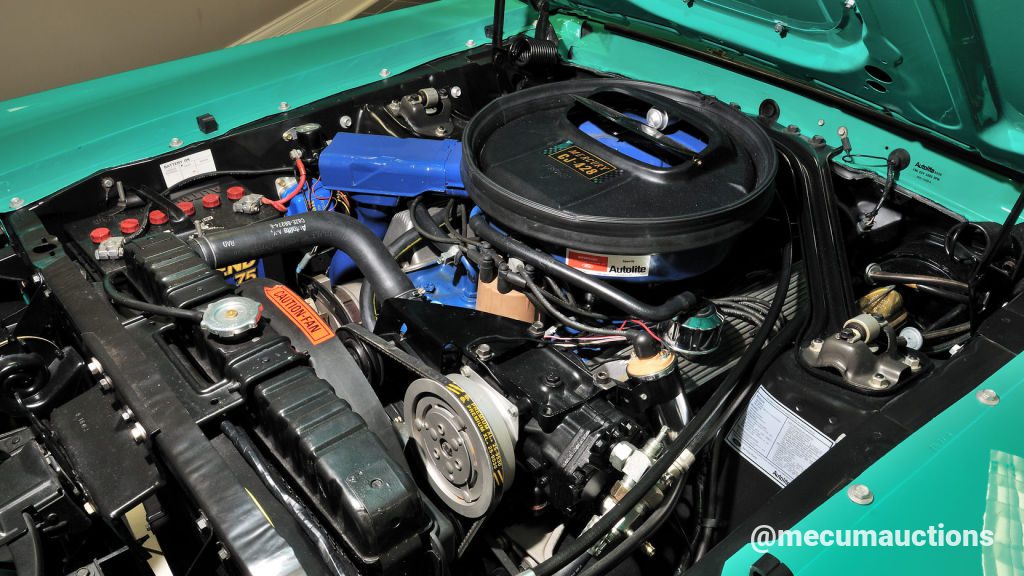
In 1970, Mercury streamlined the engine options for the Eliminator, offering just three choices: the Boss 302, 351 Cleveland, and 428 Cobra Jet.
This decision aligned with Ford’s strategy of consolidating engine options across its various models.
Despite the reduction in options, these engines were some of the most powerful available in the muscle car market, with the Boss 302 and 428 Cobra Jet engines being particularly sought-after.
The 351 Cleveland replaced the 351 Windsor engine in the 1970 Eliminator.
The 351 Cleveland was a high-performance engine with a larger and more efficient cylinder head design than the Windsor.
The Q-Code designation was used interchangeably for both Ram Air and Non-Ram Air 428 Cobra Jet engines, which could cause some confusion among enthusiasts.
Additionally, the 390 engine was dropped from the lineup for 1970, making it a rare and highly sought-after feature for collectors.
The engine options for the Mercury Cougar Eliminator ranged in price from $197 (for the 351 Cleveland engine) to $464 (for the 428 Super Cobra Jet engine). The Boss 302 engine cost an additional $479.
Engine Specs
G Code Boss 302
| Type | 8-cylinder |
| Displacement | 302cid |
| Bore & Stroke | 4.00 x 3.00 in |
| Horsepower | 290 |
| Torque | 290 lb-ft |
M Code 351 Clevland
| Type | 8-cylinder |
| Displacement | 351cid |
| Bore & Stroke | 4.00 x 3.50 in |
| Horsepower | 300 |
| Torque | 380 lb-ft |
Q Code 428 CJ
| Type | 8-cylinder |
| Displacement | 428cid |
| Bore & Stroke | 4.13 x 3.98 in |
| Horsepower | 335290 |
| Torque | 440 lb-ft |
Ordering the Drag Pak with 3.91 Traction Lock gears or the Super Drag Pak with 4.30 gears on the 428 CJ mandated a fortified bottom end and an external engine oil cooler that transformed it into the 428 SCJ.
The Super Drag Pak with 4.30 gears was also available on the Boss 302. However, no internal engine upgrades were made, but they did trigger the external engine oiler cooler.
While Mercury advertised a Boss 429 option and installed them into two cars for drag racers, they never made it to dealer’s lots for public consumption.
Performance & Handling
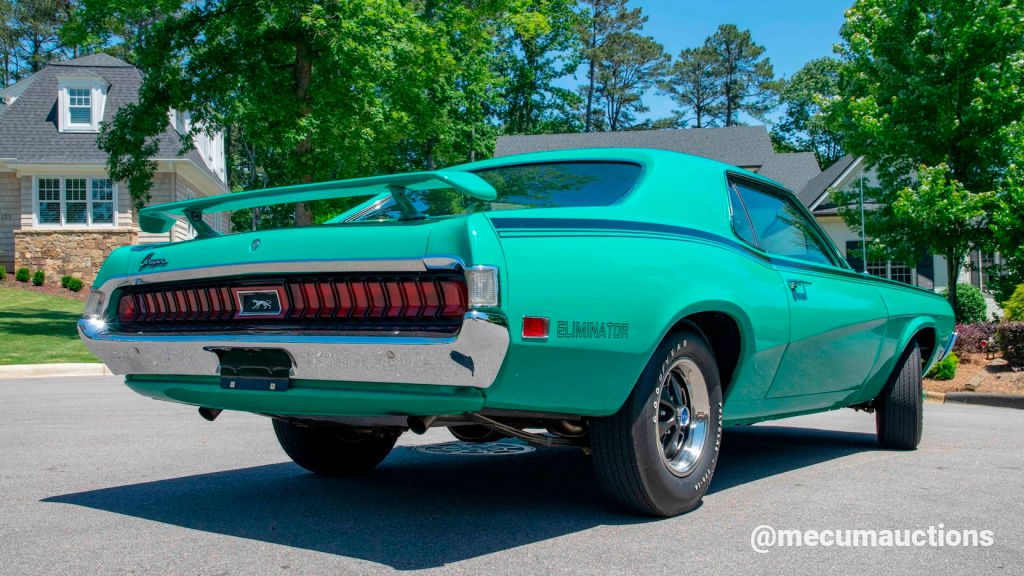
Quarter Mile Performance
In the 1970 1/2 Supercar Annual, a 1970 Courage Eliminator equipped with a 428 CJ, C-6 SelectShft automatic transmission, and a 3.91 gear ratio ran a 13.94-second quarter-mile, traveling 101 mph.
In the March 1970 issue of Hi-Performance Cars Magazine, a Boss 302 equipped 1970 Cougar Eliminator ran a 14.40-second quarter-mile, traveling 98 miles per hour.
Handling
The 1970 Mercury Cougar Eliminator offered a competition handling package that included an SLA front end with 365-ppi-rate coil springs, an asymmetrically mounted semi-elliptic leaf spring rear suspension with 148-ppi rates, 0.95-inch front and 0.50-inch rear anti-roll bars, HD 13/16-inch tube diameter shocks, and manual or optional variable-ratio power steering.
The package also included F70-14 traction belted tires, while the 428 CJ with 4-speeds and Boss 302s received staggered rear shocks for improved traction during acceleration.
Cougar Eliminator vs. Mustang Mach 1
It’s hard not to compare the Mercury Cougar Eliminator to its Ford Mustang Mach 1 cousin. They had some similarities in terms of engine options, but they had distinct design differences, including wheelbase, curb weight, length, and more.
When it came to quarter-mile performance, the Mach 1 428 Cobra Jet had the edge thanks to its lighter weight, beating the Eliminator by 0.21 seconds in 1969 and 0.29 seconds in 1970 when equipped with a 428 Cobra Jet engine.
1969
| Specification | 1969 Eliminator | 1969 Mach 1 |
|---|---|---|
| Engine | 428 Super Cobra Jet V8 | 428 Cobra Jet V8 |
| Quarter-Mile Time | 13.90 seconds | 13.69 seconds |
| Quarter-Mile Speed | 101.2 mph | 103.4 mph |
| Source | 1969 Supercar Annual | popular Hot Rodding (1/69) |
1970
| Specification | 1970 Eliminator | 1970 Mach 1 |
|---|---|---|
| Engine | 428 Super Cobra Jet V8 | 428 Cobra Jet V8 |
| Quarter-Mile Time | 14.40 seconds | 14.11 seconds |
| Quarter-Mile Speed | 98 mph | 101.1 mph |
| Source | Hi-Performance Cars (3/70) | SSDI (11/69) |
Related Questions
The 1969 and 1970 Mercury Cougar Eliminator models are considered rare and highly sought after by collectors. According to production figures, approximately 2,250 were built in 1969 and 2,268 in 1970.
The top speed varies depending on the engine size and modifications. The 1969 and 1970 models had various engine options, including the 351 Windsor, 390 V8, 428 Cobra Jet, and Boss 302. Depending on the specific engine and gearing, an Eliminator could achieve top speeds ranging from around 120 to over 140 mph.
The horsepower depends on the engine size and options. The 1969 model’s base engine was a 351 Windsor V8 that produced 290 hp, while the top-of-the-line engine was a 428 Cobra Jet V8 that produced 335 hp. For the 1970 model, the base engine was a 351 Cleveland V8 that produced 290 hp, while the top-of-the-line engine was a Boss 302 V8 that produced 290 hp.
The Cougar Eliminator was primarily designed for the Sports Car Club of America’s (SCCA) Trans-Am racing series. The Trans-Am series was a popular racing series in the late 1960s and early 1970s and featured production-based cars that were modified for racing. It competed in the Trans-Am series in 1969 and 1970 and achieved notable success, including winning the 1970 season-opening race at Riverside International Raceway.
The value of an Eliminator varies by year, engine size, condition, and rarity. A well-maintained and restored example can be worth anywhere from $50,000 to $150,000 or more, depending on the specific details and history of the car.
Conclusion
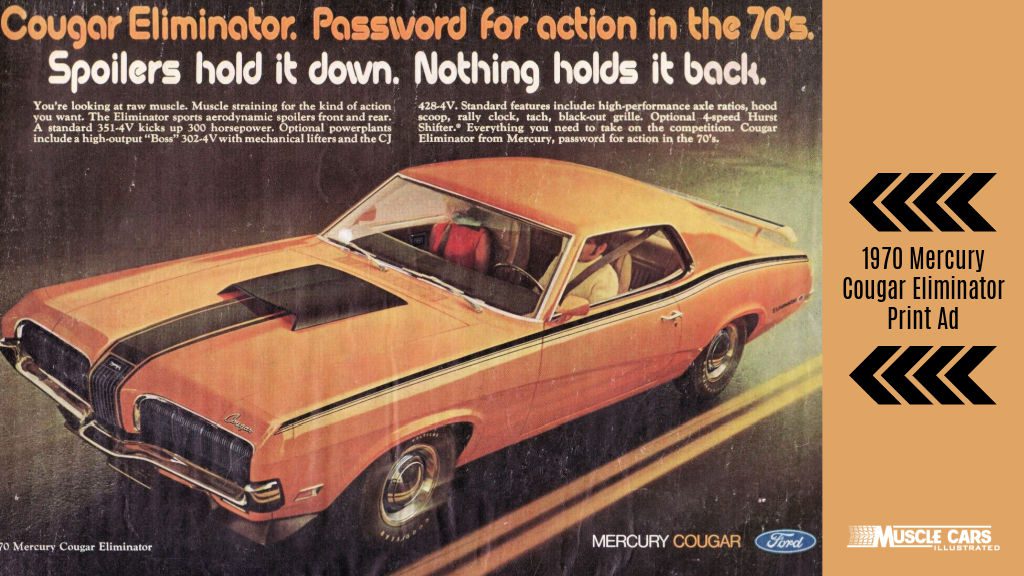
The Mercury Cougar Eliminator was a car that left an indelible mark on the American muscle car scene in the late 1960s and early 1970s. Introduced in 1969, it was the high-performance version of the Mercury Cougar.
It came with many upgrades, including a powerful V8 engine, a sporty appearance package, and various performance enhancements.
One of the most significant achievements of the Cougar Eliminator was its success on the racetrack. The car was a regular competitor in the Trans-Am racing series and won several races.
Its success on the track helped cement its reputation as a high-performance car, making it a popular choice among racing enthusiasts.
The Cougar Eliminator also helped to establish the Mercury brand as a serious contender in the muscle car market.
Overall, it was a car that captured the spirit of the muscle car era. Its combination of performance, style, and racing pedigree made it a standout car of its time.
The Mercury Cougar Eliminator represented a significant milestone in the history of the Mercury brand and played an essential role in the evolution of American muscle cars.
Take Our Poll!
"*" indicates required fields

Ryan Wheaton
Ryan has owned muscle cars since 1986 and currently owns a 1972 Dodge Charger Rallye. He combines passion and experience to create engaging content for fellow muscle car enthusiasts. In 2018, he founded Muscle Cars Illustrated, authoring hundreds of articles on tips, history, and trends in the muscle car industry. He attends national car shows, auctions, and museums to stay current with the latest developments in the muscle car industry.Comments
Comments are closed.


Hey Ryan, another great article. Thank you. Probably the most extensive Eliminator article I’ve seen. Your articles are popular topics in my Muscle Car Crush Facebook group. Keep up the great work!
Thank you for the comment, Colin! I appreciate your message and that you post my articles to your Facebook Group. I’m honored!